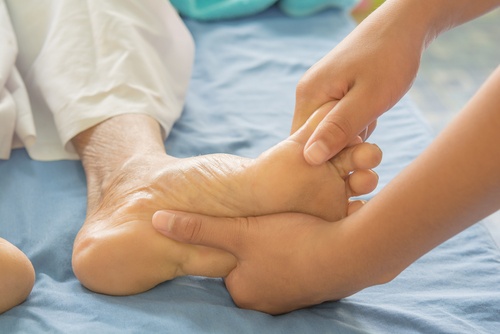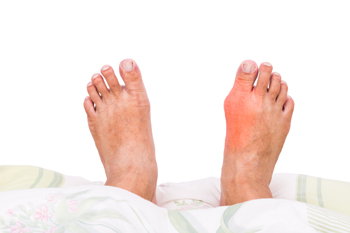 There are many people who are aware of and enjoy the benefits of foot massages. Research has indicated they may help to promote a more restful sleep, in addition to improved blood circulation, and general aches and pains may be relieved. Pregnant women find it can help to reduce swelling in the feet and ankles, and menopause symptoms, such as hot flashes, may be decreased. Patients enjoy the relaxing sensation when warm oil is used during the massage, while pressing underneath each toe. If you would like to know more about the benefits of getting regular foot massages, please confer with a podiatrist who can advise you on what type of foot therapy is right for you.
There are many people who are aware of and enjoy the benefits of foot massages. Research has indicated they may help to promote a more restful sleep, in addition to improved blood circulation, and general aches and pains may be relieved. Pregnant women find it can help to reduce swelling in the feet and ankles, and menopause symptoms, such as hot flashes, may be decreased. Patients enjoy the relaxing sensation when warm oil is used during the massage, while pressing underneath each toe. If you would like to know more about the benefits of getting regular foot massages, please confer with a podiatrist who can advise you on what type of foot therapy is right for you.
Foot therapy is often necessary for those recovering from either foot deformities or foot injuries. If you have concerns regarding therapy, consult with Dr. Richard DiMario from Maine. Our doctor can provide the care you need to keep you pain-free and on your feet.
Most Common Injuries
People who are active or athletes are prone to a variety of injuries. Therefore, it is often important to take part in physical therapy in order to quickly get back on the right track.
What to Do When Injured
Physical Therapy – This specialized treatment will focus on the affected area, speeding up recovery and the overall healing process. It is a proven method that has helped millions of people return from any injury.
During physical therapy you will undergo regimented training to get back into full form. Training is often very difficult, especially at first when the foot feels weak. Physical therapy often involves:
Basic stretching and twisting exercises – getting the feet’s mobility and flexibility up.
Massaging – the therapist will massage the injured area in order to activate the muscles and relax them.
Strengthening Exercises – this allows the muscles in the affected area to regain their full strength, a vital step towards full recovery.
If you have any questions please feel free to contact our office located in York, ME . We offer the newest diagnostic tools and technology to treat your foot and ankle needs.
 The medical condition that causes the toes to bend downward may be referred to as hammertoe. The muscles and ligaments in the middle toes are generally affected, and can appear deformed. There are several reasons that may cause this ailment to develop. These can include having high arches, enduring a toe injury, genetics, and wearing shoes that do not fit correctly. Additionally, existing medical conditions like arthritis may gradually cause hammertoe to develop. Research has indicated that it may be difficult for the toes to straighten out when hammertoe exists, and this may be a result of wearing shoes that are extremely pointed. Many patients experience pain and discomfort with hammertoe, and it is suggested that you consult with a podiatrist as quickly as possible who can offer you the best treatment techniques.
The medical condition that causes the toes to bend downward may be referred to as hammertoe. The muscles and ligaments in the middle toes are generally affected, and can appear deformed. There are several reasons that may cause this ailment to develop. These can include having high arches, enduring a toe injury, genetics, and wearing shoes that do not fit correctly. Additionally, existing medical conditions like arthritis may gradually cause hammertoe to develop. Research has indicated that it may be difficult for the toes to straighten out when hammertoe exists, and this may be a result of wearing shoes that are extremely pointed. Many patients experience pain and discomfort with hammertoe, and it is suggested that you consult with a podiatrist as quickly as possible who can offer you the best treatment techniques.
Hammertoe
Hammertoes can be a painful condition to live with. For more information, contact Dr. Richard DiMario from Maine. Our doctor will answer any of your foot- and ankle-related questions.
Hammertoe is a foot deformity that affects the joints of the second, third, fourth, or fifth toes of your feet. It is a painful foot condition in which these toes curl and arch up, which can often lead to pain when wearing footwear.
Symptoms
Causes
Genetics – People who are genetically predisposed to hammertoe are often more susceptible
Arthritis – Because arthritis affects the joints in your toes, further deformities stemming from arthritis can occur
Trauma – Direct trauma to the toes could potentially lead to hammertoe
Ill-fitting shoes – Undue pressure on the front of the toes from ill-fitting shoes can potentially lead to the development of hammertoe
Treatment
Orthotics – Custom made inserts can be used to help relieve pressure placed on the toes and therefore relieve some of the pain associated with it
Medications – Oral medications such as anti-inflammatories or NSAIDs could be used to treat the pain and inflammation hammertoes causes. Injections of corticosteroids are also sometimes used
Surgery – In more severe cases where the hammertoes have become more rigid, foot surgery is a potential option
If you have any questions please contact our office located in York, ME . We offer the newest diagnostic and treatment technologies for all your foot and ankle needs.
 One of the first symptoms many patients experience with plantar fasciitis is heel pain. Additionally, discomfort can be felt in the arch area and may be pronounced after standing for extended periods of time throughout the day. This ailment is caused by an inflammation of the plantar fascia and can happen from wearing shoes that do not fit correctly. The plantar fascia is a band of tissue that is located on the sole of the foot, and connects the heels to the toes. Patients may find mild relief when the affected foot is massaged, and it may help to wear custom made orthotics. In severe cases, surgery may be a necessary option which may help to permanently relieve the pain. If you have developed plantar fasciitis, it is strongly recommended that you consult with a podiatrist who can provide expert treatment.
One of the first symptoms many patients experience with plantar fasciitis is heel pain. Additionally, discomfort can be felt in the arch area and may be pronounced after standing for extended periods of time throughout the day. This ailment is caused by an inflammation of the plantar fascia and can happen from wearing shoes that do not fit correctly. The plantar fascia is a band of tissue that is located on the sole of the foot, and connects the heels to the toes. Patients may find mild relief when the affected foot is massaged, and it may help to wear custom made orthotics. In severe cases, surgery may be a necessary option which may help to permanently relieve the pain. If you have developed plantar fasciitis, it is strongly recommended that you consult with a podiatrist who can provide expert treatment.
Plantar fasciitis is a common foot condition that is often caused by a strain injury. If you are experiencing heel pain or symptoms of plantar fasciitis, contact Dr. Richard DiMario from Maine. Our doctor can provide the care you need to keep you pain-free and on your feet.
What Is Plantar Fasciitis?
Plantar fasciitis is one of the most common causes of heel pain. The plantar fascia is a ligament that connects your heel to the front of your foot. When this ligament becomes inflamed, plantar fasciitis is the result. If you have plantar fasciitis you will have a stabbing pain that usually occurs with your first steps in the morning. As the day progresses and you walk around more, this pain will start to disappear, but it will return after long periods of standing or sitting.
What Causes Plantar Fasciitis?
There are some risk factors that may make you more likely to develop plantar fasciitis compared to others. The condition most commonly affects adults between the ages of 40 and 60. It also tends to affect people who are obese because the extra pounds result in extra stress being placed on the plantar fascia.
Prevention
There are a variety of treatment options available for plantar fasciitis along with the pain that accompanies it. Additionally, physical therapy is a very important component in the treatment process. It is important that you meet with your podiatrist to determine which treatment option is best for you.
If you have any questions, please feel free to contact our office located in York, ME . We offer the newest diagnostic and treatment technologies for all your foot care needs.
 Have you noticed a bump appear on the side of your big toe? If so, you may have developed a bunion. Bunions can be common among older women, however, they can affect anyone. Those affected by a bunion may experience pain, swelling, difficulty walking, a callus on or around the bunion, and a misshapen toe that leans inward, caused by the bunion. Symptoms generally worsen over time if left untreated, which is why it’s important to seek immediate care. If you believe you are experiencing symptoms of a bunion, please consult with a podiatrist for a proper diagnosis and advised treatment plan.
Have you noticed a bump appear on the side of your big toe? If so, you may have developed a bunion. Bunions can be common among older women, however, they can affect anyone. Those affected by a bunion may experience pain, swelling, difficulty walking, a callus on or around the bunion, and a misshapen toe that leans inward, caused by the bunion. Symptoms generally worsen over time if left untreated, which is why it’s important to seek immediate care. If you believe you are experiencing symptoms of a bunion, please consult with a podiatrist for a proper diagnosis and advised treatment plan.
If you are suffering from bunions, contact Dr. Richard DiMario of Maine. Our doctor can provide the care you need to keep you pain-free and on your feet.
What Is a Bunion?
A bunion is formed of swollen tissue or an enlargement of boney growth, usually located at the base joint of the toe that connects to the foot. The swelling occurs due to the bones in the big toe shifting inward, which impacts the other toes of the foot. This causes the area around the base of the big toe to become inflamed and painful.
Why Do Bunions Form?
Genetics – Susceptibility to bunions are often hereditary
Stress on the feet – Poorly fitted and uncomfortable footwear that places stress on feet, such as heels, can worsen existing bunions
How Are Bunions Diagnosed?
Doctors often perform two tests – blood tests and x-rays – when trying to diagnose bunions, especially in the early stages of development. Blood tests help determine if the foot pain is being caused by something else, such as arthritis, while x-rays provide a clear picture of your bone structure to your doctor.
How Are Bunions Treated?
If you have any questions, please feel free to contact our office located in York, ME . We offer the newest diagnostic and treatment technologies for all your foot care needs.